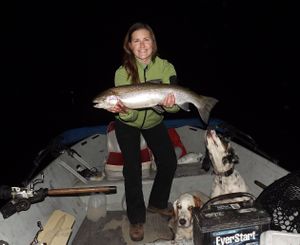Good news, bad news for Snake fish runs, biologist says
FISHING -- Some anglers are catching 10 chinook salmon a day in the Lewiston area this week in the best chinook salmon fishing season fish managers can remember. Steelheading for keepers is so-so.
The chinook salmon returns to the Snake River this fall are huge, but the steelhead returns -- notably for hatchery steelhead -- are sub-par.
The exception is a near-record post-dams return of small wild steelhead, according to Joe DuPont, Idaho Fish and Game Department regional fisheries manager in Lewiston.
Click "continue reading" for a detailed analysis of the two fisheries DuPont has just posted.
Hi everybody. I thought I would give you all an update on the status of the fall Chinook salmon and steelhead runs seeing a lot of rumors are starting to fly.
I’ll start with the good news.
The fall Chinook salmon fishery has been as good as we have seen it. Last week most of the effort was around the confluence of the Snake and Clearwater rivers and catch rates ranged from 7 to 10 hrs a fish. In case you are wondering, that is excellent for this fishery as many people are just learning how to catch fall Chinook salmon. A few people who have it dialed in are catching around 10 fish a day. Many people have been commenting that they can’t hardly catch a fish with a clipped adipose fin (you can only keep clipped fish). The reason for this is about 30% of the fall Chinook salmon coming over Lower Granite Dam are clipped, and this matches up almost exactly with what people report catching in our creel surveys. Based on what we are seeing come over Bonneville Dam, we are projecting the adult fall Chinook run coming to Idaho will be around 52,000 fish. It that comes true, this will be a record high since the Dams went in. One of the nice things about fall Chinook salmon is they tend to be larger than the spring and summer fish. Many of the fall Chinook spend 3 or 4 years in the ocean whereas most of the spring run fish spend 2 years in the ocean. A few of the PIT tagged fall Chinook salmon returning this year actually spent 5 years in the Ocean, and these are those fish that can reach around 50 lbs. I’ve heard of several fish of this size being caught, but all had to be released because they weren’t clipped. Who know, maybe you may be the next lucky one to hook into one of these monsters. Right now the rivers are cooling considerably and the fall Chinook salmon are starting to migrate upriver. As a result, I expect fishing to improve upriver this week. Right now about 60% of the adult run has passed over Lower Granite Dam, so we should continue to get a lot of fresh fish entering Idaho for at least the next couple of weeks. Don’t expect them to stack up around the confluence as much as they did when the water temperatures were warmer, but I suspect the fishing should continue to be good in this area for at least a couple more weeks.
Now for the Steelhead. The tables below show the number of steelhead that have passed over the Lower Granite Dam since 1986. The yellow circles are what we are predicting this year based on what has come over Bonneville Dam. The large steelhead are fish greater than 78 cm (~31 inches) and generally reflects the number of the steelhead that will be returning to the Clearwater River. The small steelhead are fish < 78 cm and generally reflects the number of the steelhead that will be returning to the Snake and Salmon rivers. As you can see from these graphs, the projected run for the larger steelhead (mostly Clearwater fish) is down for both hatchery and wild fish. In fact, if you look at the graph of the larger hatchery fish you have to go back to the 1994-5 to find a run year that is lower than this year’s current prediction. Some are already asking, “does this mean you will adjust the steelhead rules in the Clearwater?” Last year (also a down year) we didn’t need to make any changes in the steelhead rules as the fishery was is often self-regulating. In other words, when fewer fish enter the river, fewer people tend to fish and fewer fish are caught. That doesn’t necessarily mean the fishing is going stink. I talked to some people who had some of their best fishing days ever last year, and that is because there is often less competition for the fish that are there. Now all that being said, this year’s run is projected to be even smaller than last year’s, so we will be evaluating all our data to see if any changes need to be made to the steelhead rules. Our goals is to maintain a desirable steelhead fishery while still allowing us to meet our brood stock goals. I’ll keep you all posted on what we learn and are thinking.
The predictions for this year’s run of smaller steelhead is very interesting. We are expecting to see a near record run (for recent times) of smaller wild steelhead whereas the projection for small hatchery steelhead is down (similar to last year). This tells me something is going on with our hatchery fish as we would hope that in good wild run years we would also see good hatchery runs. One of the things that may explain for some of this difference is some of the Snake and Salmon river hatchery steelhead released last year tended to be smaller than normal. As I am learning, there is a lot more to raising fish than cleaning the raceway and throwing some food at them. The ingredients in the food, the buoyancy of the feed, how the fish are fed, water temperatures, flow, cleanliness, and disease control are all things that can make a difference in how fast fish grow and how healthy they are. In recent years, steelhead in some of the hatcheries have just stopped feeding which obviously reduced growth. In addition, at one of our hatcheries we had to do some repairs and had to release our steelhead earlier than normal which also resulted in releasing smaller fish than normal. These smaller fish likely had lower survival than larger fish would have. There are certainly other factors that I’m not aware of that could have played a role in lower survival of hatchery fish as well. Right now we think we have figured out the feed issue and repairs are all complete so hopefully in the future all our steelhead will reach our size at release goals. Last week fishing for steelhead was quite slow, but I expect it to pick up this week due to the cooler water temperatures and increased number of fish passing over Lower Granite Dam.

